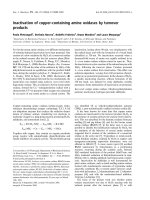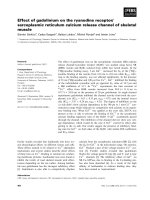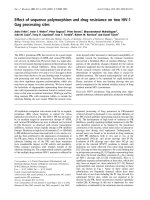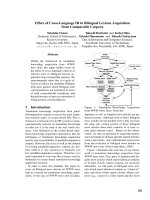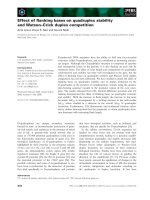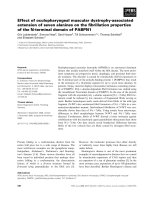Báo cáo khoa học: " Effect of probiotic containing Saccharomyces boulardii on experimental ochratoxicosis in broilers: hematobiochemical studies" docx
Bạn đang xem bản rút gọn của tài liệu. Xem và tải ngay bản đầy đủ của tài liệu tại đây (469.25 KB, 5 trang )
-2851$/ 2)
9H W H U L Q D U \
6FLHQFH
J. Vet. Sci.
(2004),
/
5
(4), 353–357
Effect of soluble porcine aminopeptidase N on antibody production against
porcine epidemic diarrhea virus
Jin Sik Oh
1
, Dae Sub Song
1
, Jeong Sun Yang
1
, Ju Young Song
1
, Han Sang Yoo
2
, Yong Suk Jang
3
, Bong Kyun Park
1,
*
1
Department of Veterinary Virology, College of Veterinary Medicine and School of Agricultural Biotechnology,
Seoul National University, Seoul 151-742, Korea
2
Department of Veterinary Infectious Disease, College of Veterinary Medicine and School of Agricultural Biotechnology, Seoul
National University, Seoul 151-742, Korea
3
Division of Biological Science and the Institute for Molecular Biology and Genetics, Chonbuk National University,
Jeonju 561-756, Korea
A few members of coronavirus group I which includes
porcine epidemic diarrhea virus (PEDV) use porcine
aminopeptidase N (pAPN) as a cellular receptor. Cellular
receptors play an important role in virus attachment and
entry. However, the low permissiveness of PEDV to APN-
expressing porcine cell lines has made it difficult to
elucidate the role of pAPN
in vitro
. The purpose of this
study was to prove whether the treatment of soluble
pAPN could enhance the antibody production against
PEDV in guinea pigs, rabbits and sows. The animals (20
guinea pigs, 8 rabbits and 20 sows) were divided into 4
groups. Group A was injected intramuscularly (IM) with
soluble pAPN at one hour before intramuscular infection
of PEDV on the same site, group B for IM simultaneous
injection of pAPN and PEDV, and group C for IM
injection of PEDV only. Group D served as a control of
pAPN treatment or PEDV infection. Antibody production
against PEDV was compared among groups at regular
intervals. The results suggested that pAPN could enhance
the antibody production against PEDV in guinea pigs and
rabbits which are free of pAPN, however, the effect of
pAPN treatment in sows was not clearly elucidated.
Key words:
Porcine epidemic diarrhea virus, porcine ami-
nopeptidase N, immune responses
Introduction
Aminopeptidase N (APN) acts as a cellular receptor of
coronavirus group I, such as transmissible gastroenteritis
virus (TGEV) [1,7,25], feline infectious peritonitis virus
(FIPV) [22] and human respiratory coronavirus (HCoV)-
229E [27]. Porcine epidemic diarrhea virus (PEDV) is a
member of the coronavirus group [23,24], and causes watery
diarrhea, dehydration and high mortality in suckling pigs
[2,17]. Similar to transmissible gastroenteritis virus (TGEV),
PEDV replicates in the enterocytes present in the villi of
small intestine [5,6] and is cultured in Vero cells [10,12,13],
porcine bladder and kidney cells [20], and swine cell line
KSEK6 and IB-RS-2 cells [11]. In some viruses like human
immunodeficiency virus (HIV), soluble cellular receptors
can enhance the infectivity of the virus [19]. Recently,
soluble porcine APN (pAPN) could enhance PEDV
infectivity in Vero cells [16]. However, it has not been
reported whether the treatment of soluble pAPN is helpful
for enhancing the antibody production against PEDV
in
vivo
. This work was carried out to determine whether the
antibody production against PEDV would be enhanced by
soluble pAPN treatment in guinea pigs and rabbits as
nonpermissive hosts and sows for a permissive host.
Materials and Methods
Cell and virus
Continuous Vero cell line (ATCC, CCL-81) was regularly
maintained in
α
-minimum essential medium (
α
-MEM)
supplemented with 5% fetal bovine serum and antibiotics.
The cell passaged PEDV, KPEDV-9 strain [14] was kindly
provided by the Green Cross Veterinary Product Co. Ltd.
(Suwon, Korea). The virus was propagated in Vero cells
with virus replication medium of
α
-MEM supplemented
0.02% yeast extract, 0.3% tryptose phosphate broth and
2
µ
g of trypsin (T-VM).
Animals
Guinea pigs:
Four groups of 5 guinea pigs (200 g body
*Corresponding author
Tel: +82-2-880-1255; Fax: +82-2-885-0263
E-mail:
354 JinSik Oh
et al.
weight) were allocated as shown in Table 1. In group A,
1 ml of the soluble pAPN (Sigma, USA) at the
concentration of 10
µ
g/ml was injected IM. After 1 hour of
pAPN injection, 1 ml of PEDV (10
4.5
TCID
50
/ml) was
infected at the same inoculation site. Group B was injected
simultaneously with 1 ml of PEDV (10
4.5
TCID
50
/ml)
containing soluble pAPN at the concentration of 2.4 pg/ml.
Group C was infected with 1 ml of PEDV (10
4.5
TCID
50
/ml)
only without pAPN and group D was a control of T-VM. All
guinea pigs were raised for 6 weeks after inoculation. Blood
samples were collected weekly from each guinea pig for
serum neutralization (SN) test.
Rabbits: Four groups of 2 rabbits (1.5 Kg body weight)
were allocated as indicated in Table 1. Group A of rabbits
was treated as the same protocol described in the group A of
guinea pigs. Group B was injected simultaneously with 1 ml
of PEDV (10
4.5
TCID
50
/ml) containing soluble pAPN at the
concentration of 24 pg/ml. Group C was injected with 1 ml
of PEDV (10
4.5
TCID
50
/ml) only without pAPN treatment,
and group D was a control of T-VM. Booster injection was
performed by the same protocol of described above at 3
weeks later. All rabbits were raised for 6 weeks after
inoculation. Sera were taken every week for serological
analysis.
Sows:
Twenty commercial pregnant sows (Landrace
×
Yorkshire), regardless of parity number, were employed to
investigate whether the antibody production against PEDV
would be enhanced by soluble pAPN from a commercial
swine farm. All sows were housed separately in a stall and
fed with a commercial feed. Four groups of five sows each
were allocated as shown in Table 1. Commonly, inoculation
route was IM and the titer of PEDV was 10
4.5
TCID
50
/ml.
Group A of sows was treated as the same protocol described
in the group A of guinea pigs. Group B was injected
simultaneously with 1 ml of PEDV containing soluble
pAPN at the concentration of 24 ng/ml. Group C was
injected with 1 ml of PEDV only without pAPN treatment,
and group D was a control of T-VM. Two inoculations were
carried out by the same protocol described previously at 5
weeks and 2 weeks before farrowing. Blood samples were
collected from each sow before each injection and at
farrowing. Colostrum was also collected from each sow at
farrowing. Antibody titers against PEDV in sera and
colostrum were examined by SN test, and indirect ELISA
(isotype IgG or IgA).
Serum neutralization test
The SN test was carried out by the microtiter method
using Vero cells as described previously [20]. Colostrum
was centrifuged at 12,000
×
g for 30 minutes and clear
supernatant was collected for SN test. Sera and colostrum
were heated at 56
o
C for 30 minutes before use. Serum or
colostrum diluted serially in two-fold were mixed with an
equal volume of PEDV (200 TCID
50
). The mixture was
incubated for 1 hour at 37
o
C and 0.1 ml of virus-serum
mixture was inoculated into each well of Vero cell
monolayers. Following adsorption for 1 hour at 37
o
C, the
inocula were removed and the monolayers were washed
three times with T-VM. Then, 0.1 ml of T-VM was added to
each well and the cultures were incubated for 5 days at 37
o
C.
The antibody titer was expressed as the reciprocal of the
highest serum dilution that inhibited cytopathic effect
(CPE).
Indirect ELISA
The indirect ELISA was carried out in 96-well microtiter
plate (Nalge Nunc International, USA). For antigen coating,
the PEDV ELISA and mock-infected cell antigens were
prepared as described previously [3]. The antigens were
diluted in coating buffer (50 mM carbonate buffer, pH 9.6).
Alternate 8-well rows of the plate was coated with 100
µ
l of
diluted PEDV antigen per well (0.1
µ
g/well) in coating
buffer and incubated overnight at 4
o
C
. The antigen was then
poured off and washed 5 times with phosphate buffered
saline (PBS, pH 7.4) containing 0.05% Tween 20 (Sigma,
USA). Subsequently, remaining free binding sites on the
surface were blocked with 200
µ
l of 5% rabbit serum
(Gemini Bioproducts, USA) in PBS for 1 hour at 37
o
C
. Two
Table 1.
Experimental design for soluble porcine aminopeptidase N treatments
Group pAPN treatment
1
Guinea pigs Rabbits
2
Sows
3
No. of
animal
Dose of
pAPN
No. of
animal
Dose of
pAPN
No. of
animal
Dose of
pAPN
A 1 hour before PEDV
4
infection 5 10 µg 2 10 µg 5 10 µg
B Simultaneous PEDV 5 2.4 pg 2 24 pg 5 24 ng
C PEDV only 5 - 2 - 5 -
D Control 5-2-5-
1
The animals were treated with pAPN intramuscularly.
2
The rabbits were boosted with the same protocol of the first injection at 3 weeks.
3
The sows were treated with the same protocol at 5 and 2 weeks before farrowing.
4
The volume of PEDV was 1 ml (titer, 10
4.5
TCID
50
/ml).
Effect of soluble pAPN on antibody production against PEDV 355
positive and negative reference each and sample swine sera
were diluted 1 : 50 in PBST. Each serum was transfered to 2
wells (100
µ
l/well) each and the plates incubated for 1 hour
at 37
o
C
. Then, HRP-conjugated goat anti-pig IgG antibody
(KPL, USA), which was diluted 1 : 2,000 in PBST, was
added to each well (100
µ
l/well). For the assay of IgA
antibody in sera and colostrum, HRP-conjugated goat anti-
pig IgA antibody (1 : 250, KPL, USA) was used. After
incubating further for 1 hour at 37
o
C
, plates were washed 5
times with PBST, and 100
µ
l of ABTS substrate (KPL,
USA) were added to each well. After incubation for 20
minutes at room temperature, the reactions were stopped by
adding 0.5 M H
2
SO
4
and optical density was measured at
405 nm. The corrected OD of each serum and colostrum
was calculated as follows.
Corrected OD = OD of a test serum on the PEDV antigen
- OD of a test serum on the mock-infected cell antigen.
Statistical analysis
To compare the difference between the control group and
the other groups during the entire period of experiment,
ANOVA test was used using Microcal Origin 6.0 (Microcal
Software, USA).
Results
Comparison of neutralizing antibody production against
PEDV in animals
Immune responses in guinea pigs:
The SN antibody
production of guinea pigs was depicted in Fig. 1. All of the
guinea pigs in the groups A, B, and C developed SN
antibodies against PEDV from 1 week after PEDV
inoculation. However, the T-VM inoculated guinea pigs as a
control (group D) remained seronegative during the
experiment. In guinea pigs pre-treated with pAPN at the
concentration of 10
µ
g per guinea pig (group A), SN titers
were constant and significantly higher than group C until 6
weeks after PEDV inoculation (
p
< 0.01). The guinea pigs
inoculated simultaneously with PEDV and pAPN responded
dramatically to the PEDV infection as shown in Fig. 1. The
maximum SN titers in guinea pigs of group B were 2
5.2
at 1
and 2 weeks after PEDV infection and then slowly
decreased. However, PEDV antibody titers of group B were
significantly higher than those of group C until 5 weeks after
PEDV inoculation (
p
< 0.01). Significant difference in SN
titers between group A and B showed only at 1 and 2 weeks
after PEDV inoculation (
p
< 0.01). Group C which was
inoculated with PEDV only showed the highest titer at 2
weeks (2
2.8
) and slowly declined. Therefore, the titers were
as low as 2
2.4
folds when compared to the maximum titer of
group B guinea pigs.
Immune responses in rabbits:
The SN antibody production
of rabbits was depicted in Fig. 2. All of the rabbits in the
groups A, B, and C developed SN antibodies against PEDV
from 1 week after PEDV inoculation. However, the T-VM
inoculated rabbits as a control (group D) remained
seronegative during the experiment. In rabbits pre-treated
with pAPN at the concentration of 10
µ
g per rabbit (group
A), SN titers were significantly higher than group C after
boosting at 3 weeks after PEDV infection (
p
< 0.01). The
rabbits infected simultaneously with PEDV and pAPN
responded dramatically to the PEDV infection as shown in
Fig. 2. The maximum SN titers in rabbits of group B were
2
8.0
at 5 weeks after PEDV infection and then slowly
decreased. However, PEDV antibody titers of group B were
significantly higher than those of group C after boosting at 3
weeks after PEDV infection (
p
< 0.01). Significant
difference in SN titers between group A and B showed from
4 weeks after PEDV infection (
p
< 0.01). Group C which
was infected with PEDV only showed the highest titer at 4
weeks (2
5.0
) and slowly declined. Therefore, the titers were
as low as 2
3.0
folds when compared to the maximum titer of
group B rabbits.
Immune responses in sows:
The SN antibody production
of sows was depicted in Fig. 3. All of the sows in the groups
A, B, and C developed SN antibodies against PEDV, even
though the significant differences of SN antibody titers
F
ig. 1.
Neutralizing antibody titers against PEDV in guinea pig
s.
T
iters were described in mean ± S.E.
F
ig. 2.
Neutralizing antibody titers against PEDV in rabbits. T
he
r
abbits were boosted at 3 weeks. Titers were described
in
m
ean ± S.E.
356 JinSik Oh
et al.
among the groups were not observed (
p
< 0.01). However,
the T-VM inoculated sows as a control (group D) remained
seronegative during the experiment. In the SN test, the
average antibody titers were 2
6.00
in group A, 2
5.60
in group B,
and 2
5.75
in group C before boosting at 2 weeks before
farrowing, respectively. At farrowing, the antibody titers of
colostrum were increased to 2
6.60
in group A, 2
6.40
in group B,
and 2
6.38
in group C, respectively, suggesting no significant
difference among the groups.
Comparison of Ig isotype titers against PEDV in sows:
In the indirect ELISA for detection of IgG isotype against
PEDV, corrected ODs of sow sera from groups A, B, and C
were 0.365, 0.372 and 0.313 at farrowing, respectively.
However, IgG titers both sera and colostrum did not show
the significant differences among the groups (Fig. 4A). In
detecting IgA isotype against PEDV, corrected Ods of sow
sera from groups A, B and C were 0.293, 0.283 and 0.261 at
farrowing, respectively. However, IgA titers both sera and
colostrum did not show the significant differences among
the groups in this experiment (Fig. 4B).
Discussion
As the first step in viral infection, viruses attach to specific
receptors on the surface of cells. This specific interaction
with cells determines, to a large extent, the host-range
specificities and tissue tropism of viruses [4,9,21].
Characterization of the host-virus interaction ultimately
requires isolation of the cellular receptor and the virus
attachment protein. While several virus attachment proteins
have been identified [8,15,18], little is known about the
nature and properties of cellular receptors against PEDV.
The present study demonstrated that the treatment of
soluble pAPN which is a cellular receptor of coronavirus
group I could enhance the antibody production against
PEDV in guinea pigs and rabbits. Single inoculation of
PEDV with pAPN increased significantly SN titers in
guinea pigs up to four weeks after inoculation. However, the
SN titers of rabbits had no difference between three groups
after the first inoculation, although the difference was
observed after the second inoculation. These results support
that the pre-treated or simultaneously treated pAPN may
play a role in PEDV attachment and entry in the muscle cells
of experimental animals. Thus, the increased entry of PEDV
into the muscle cells might induce higher antibody
production against PEDV when compared to PEDV
inoculation only without pAPN treatment. However, these
results could be explained that pAPN treatment may play a
role of simple potent adjuvant leading to macromolecules
which easily bound to antigen presenting cells in
experimental animals. In addition, as molecular mechanisms
of dendritic cell-induced T cell activation, pAPN appeared
to be involved in activation of naïve T cells (CD13) [26].
Sows did not make difference even though pAPN was
treated before or simultaneous inoculation of PEDV. This
phenomenon was observed regardless of the methods of
serological test; SN test and indirect ELISA. However, the
ELISA practically could measure all of the possible
subclasses of immunoglobulin against PEDV. It is thought
that no difference in sows would be due to the improper
F
ig. 4.
Antibody titers against PEDV in sows by indirect ELIS
A.
T
he sows were treated at 5 and 2 weeks before farrowin
g.
A
bsorbance were described in mean ± S.E. A; IgG, B; IgA.
F
ig. 3.
Neutralizing antibody titers against PEDV in sows. T
he
s
ows were treated at 5 and 2 weeks before farrowing. Titers we
re
d
escribed in mean ± S.E.
Effect of soluble pAPN on antibody production against PEDV 357
concentration of pAPN treatment when compared to body
weights of animals used. On the other hand, it could be due
to a reason why sows hold enough distribution of pAPN in
the enterocytes of small intestine villi [5,6]. Therefore, the
antibody production against PEDV in pigs may be enhanced
with the aid of higher concentration of pAPN than that in
experimental animals.
Acknowledgments
This work was supported by the Korea Research
Foundation Grants (KRF-2002-070-C00069), the Brain
Korea 21 Project of the Ministry of Education & Human
Resources Development, and the Research Institute for
Veterinary Science (RIVS), Seoul National University,
Korea.
References
1. Benbacer L, Stinackre MG, Laude H, Delmas B.
Obtention of porcine aminopeptidase-n transgenic mice and
analysis of their susceptibility to transmissible gastroenteritis
virus. Adv Exp Med Biol 1998, 440, 53-59.
2. Chasey D, Cartwright SF. Virus-like particles associated
with porcine epidemic diarrhea. Res Vet Sci 1978, 25, 255-
256.
3. Chu HJ, Zee YC. Morphology of bovine viral diarrhea
virus. Am J Vet Res 1984, 45, 845-850.
4. Crowell RJ, Landau BJ. Comprehensive virology, pp. 1-42,
Plenum Publish Corp. New York. 1983.
5. De Bouck P, Pensaert M. Experimental infection of pigs
with a new porcine enteric coronavirus, CV777. Am J Vet
Res 1980, 41, 219-223.
6. De Bouck P, Pensaert M, Coussement W. The pathogenesis
of an enteric infection in pigs, experimentally induced by the
coronavirus-like agent, CV777. Vet Microbiol 1981, 6, 157-
165.
7. Delmas B, Gelfi J, L’Haridon R, Vogel LK, Sjostrom H,
Noren O, Laude H. Aminopeptidase N is a major receptor
for the enteropathogenic coronavirus TGEV. Nature 1992,
357, 417-420.
8. Dorsett PH, Ginsberg HS. Characterization of type S
adenovirus fiber protein. J Virol 1975, 15, 208-216.
9. Field BN, Greene MI. Genetic and molecular mechanisms
of viral pathogenesis: implications for prevention and
treatment. Nature 1982, 300, 19-23.
10. Hoffman M, Wyler R. Propagation of the virus of porcine
epidemic diarrhea in cell culture. J Clin Microbiol 1988, 26,
2235-2239.
11. Kadoi K, Sugiok H, Satoh T, Kadoie BK. The propagation
of a porcine epidemic diarrhea virus in swine cell lines. New
Microbiol 2002, 25, 285-290.
12. Kusanagi K, Kuwahara H, Katoh T, Nunoya T, Ishikawa
Y, Samejima T, Tajima M. Isolation and serial propagation
of porcine epidemic diarrhea virus infection in cell cultures
and partial characterization of the isolate. J Vet Med Sci
1992, 54, 303-318.
13. Kweon CH, Kwon BJ, Jung TS, Kee YJ, Hur DH, Hwang
EK, Rhee JC, An SH. Isolation of porcine epidemic
diarrhea virus(PEDV) in Korea. Korean J Vet Res 1993, 33,
249-254.
14. Kweon CH, Kwon BJ, Lee JG, Kwon GO, Kang YB.
Derivation of attenuated porcine epidemic diarrhea virus
(PEDV) as vaccine candidate. Vaccine 1999, 17, 2546-2553.
15. Lee PWK, Hayes EL, Joklik WK. Protein sigma I is the
reovirus cell attachment protein. Virology 1981, 108, 156-
163.
16. Oh JS, Song DS, Park BK. Identification of a putative
cellular receptor 150 kDa polypeptide for porcine epidemic
diarrhea virus in porcine enterocytes. J Vet Sci 2003, 4, 269-
275.
17. Pensaert MB, De Bouck P. A new coronavirus-like particles
associated with diarrhea in swine. Arch Virol 1978, 58, 243-
247.
18. Scheid A. Subviral components of myxo- and paramyxo-
viruses which recognize receptors. Chapman and Hall, Ltd.,
London, 1981, p. 49-59.
19. Schenten D, Marcon L, Karlsson GB, Parolin C, Kodama
T, Gerard N, Sodroski J. Effect of soluble CD4 on simian
immunodeficiency virus infection of CD4-positive and CD4-
negative cells. J Virol 1999, 73, 5373-5380.
20. Shibata I, Tsuda T, Mori M, Ono M, Sueyoshi M, Uruno
K. Isolation of porcine epidemic diarrhea virus in porcine
cell cultures and experimental infection of pigs of different
ages. Vet Microbiol 2000, 72, 173-182.
21. Tomassini JE, Colonno RJ. Isolation of receptor protein
involved in attachment of human rhinoviruses. J Virol 1986,
58, 290-295.
22. Tresnan DB, Holmes KV. Feline aminopeptidase N is a
receptor for all group I coronaviruses. Adv Exp Med Biol
1998, 440, 69-75.
23. Utiger A, Tobler K, Bridgen A, Akermann M.
Identification of the membrane protein of porcine epidemic
diarrhea virus. Virus Genes 1995, 10, 137-148.
24. Utiger A, Tobler K, Bridgen A, Suter M, Singh M,
Ackermann M. Identification of proteins specified by
porcine epidemic diarrhoea virus. Adv Exp Med Biol 1995,
380, 287-290.
25. Weingartl HM, Derbyshire JB. Cellular receptor for
transmissible gastroenteritis virus on porcine enterocyte. Adv
Exp Med Biol 1995, 53, 325-329.
26. Woodhead VE, Stonehouse TJ, Binks MH, Speidel K, Fox
DA, Gaya A, Hardie D, Henniker AJ, Horejsi V, Sagawa
K, Skubitz KM, Taskov H, Todd III RF, Van Agthoven A,
Katz DR, Chain BM. Novel molecular mechanisms of
dendritic cell-induced T cell activation. Int Immunol 2000,
12, 1051-1061.
27. Yeager CL, Ashmun RA, Williams RK, Cardellichio CB,
Shapiro LH, Look AT, Holmes KV. Human aminopeptidase
N is a receptor for human coronavirus 229E. Nature 1992,
357, 420-422.


